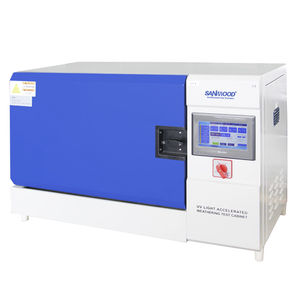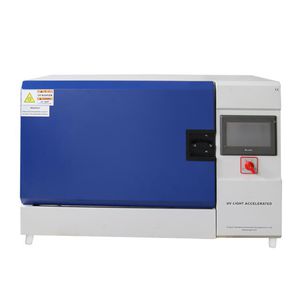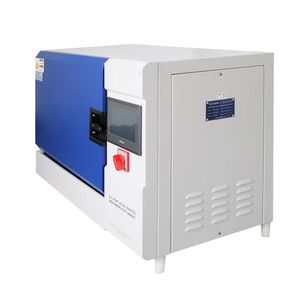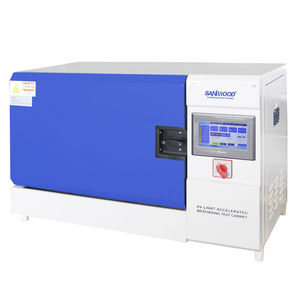
- Metrología - Laboratorio
- Metrologia y Ensayos
- Cámara climática
- Sanwood Technology
Cámara climática SM-UV-800de temperaturaUV

Añadir a mis favoritos
Añadir al comparador
Características
- Tipo
- climática
- Parámetro controlado
- de temperatura
- Fuente luminosa
- UV
- Temperatura
Máx.: 70 °C
(158 °F)Mín.: 30 °C
(86 °F)- Eslora
500 mm
(19,69 in)- Anchura
1.170 mm
(46,1 in)- Profundidad
600 mm
(24 in)
Descripción
Simulated humid condensation environment
In many outdoor environments, materials can be wet for up to 12 hours a day. Studies have shown that the main cause of this outdoor humidity is dew, not rain. The BUV simulates outdoor wet erosion through a unique condensation function. During the condensation cycle during the test, the water in the reservoir at the bottom of the test chamber is heated to produce hot vapor and fills the entire test chamber. The hot steam maintains the relative humidity in the test chamber at 100% and maintains a relatively high temperature.
The sample is fixed to the side wall of the test chamber so that the test surface of the sample is exposed to the ambient air in the test chamber. The outward side of the sample is exposed to the natural environment and has a cooling effect, resulting in a temperature difference between the inner and outer surfaces of the sample. This temperature difference causes the sample to always condense the liquid water generated during the entire condensation cycle.
Since the exposure time to outdoor exposure can be as long as ten hours per day, a typical condensation cycle typically lasts for several hours. The BUV offers two wet simulation methods. The most widely used method is the condensation method, which is the best way to simulate outdoor wet erosion. At the same time, BUV also provides a wet way of water spray. All BUV can run both a condensing cycle and a water spray cycle.
VÍDEO
Otros productos de Sanwood Technology
UV Lamp Weathering Test Chamber
Búsquedas asociadas
- Máquina de ensayo
- Célula de ensayo
- Máquina de medición
- Máquina de prueba para materiales
- Célula de ensayo de temperatura
- Máquina de ensayo automática
- Máquina de prueba controlada por PC
- Cámara de pruebas climática
- Máquina de ensayo de compresión
- Célula de ensayo de humedad
- Máquina de ensayo vertical
- Máquina de ensayo universal
- Máquina de ensayo de tensión
- Máquina de ensayo de flexión
- Comprobador para la industria
- Máquina de ensayo para laboratorio
- Célula de ensayo ambiental
- Máquina de ensayo de precisión
- Célula de ensayo para control de calidad
- Célula de ensayo de acero inoxidable
* Los precios no incluyen impuestos, gastos de entrega ni derechos de exportación. Tampoco incluyen gastos de instalación o de puesta en marcha. Los precios se dan a título indicativo y pueden cambiar en función del país, del coste de las materias primas y de los tipos de cambio.





















